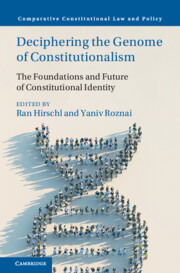Book contents
- Deciphering the Genome of Constitutionalism
- Comparative Constitutional Law and Policy
- Deciphering the Genome of Constitutionalism
- Copyright page
- Contents
- Figures
- Contributors
- Preface
- Acknowledgments
- Introduction
- Part I Foundations, Theory, and Concepts
- Part II Comparative Perspectives
- Part III American Constitutionalism and Constitutional Identity
- Part IV Emerging Trends
- 19 Constitution Making and Disharmonic Identity
- 20 Constitutional Identity and Unamendability
- 21 Illiberal Constitutionalism and the Abuse of Constitutional Identity
- 22 Deconstructing Constitutional Identity in Light of the Turn to Populism
- 23 Unconstitutional Constitutional Identities in The European Union
- 24 What Counts as Constitutional Identity?
- 25 Contrariness and Contradiction in Constitutional Law
- 26 Conclusion
- Index
- References
25 - Contrariness and Contradiction in Constitutional Law
from Part IV - Emerging Trends
Published online by Cambridge University Press: 14 March 2024
- Deciphering the Genome of Constitutionalism
- Comparative Constitutional Law and Policy
- Deciphering the Genome of Constitutionalism
- Copyright page
- Contents
- Figures
- Contributors
- Preface
- Acknowledgments
- Introduction
- Part I Foundations, Theory, and Concepts
- Part II Comparative Perspectives
- Part III American Constitutionalism and Constitutional Identity
- Part IV Emerging Trends
- 19 Constitution Making and Disharmonic Identity
- 20 Constitutional Identity and Unamendability
- 21 Illiberal Constitutionalism and the Abuse of Constitutional Identity
- 22 Deconstructing Constitutional Identity in Light of the Turn to Populism
- 23 Unconstitutional Constitutional Identities in The European Union
- 24 What Counts as Constitutional Identity?
- 25 Contrariness and Contradiction in Constitutional Law
- 26 Conclusion
- Index
- References
Summary
In Constitutional Identity, Gary Jacobsohn highlights the tension both within constitutional systems and between constitutions and societal norms (culture). In this essay, we explore the first tension and glance at the second. One objective of the essay is to enumerate a set of “disharmonies” that appear with some frequency within constitutions and, employing historical data, identify the constitutional systems that contain them. Appealing to formal logic, we develop a taxonomy that helps us understand the kinds of disharmonies on display; a taxonomy that points to their sources. The essay thus generalizes Jacobsohn’s notion of disharmony and extends his insights from a small set of cases that begin with the letter “I” to a larger set.
Keywords
- Type
- Chapter
- Information
- Deciphering the Genome of ConstitutionalismThe Foundations and Future of Constitutional Identity, pp. 330 - 344Publisher: Cambridge University PressPrint publication year: 2024



